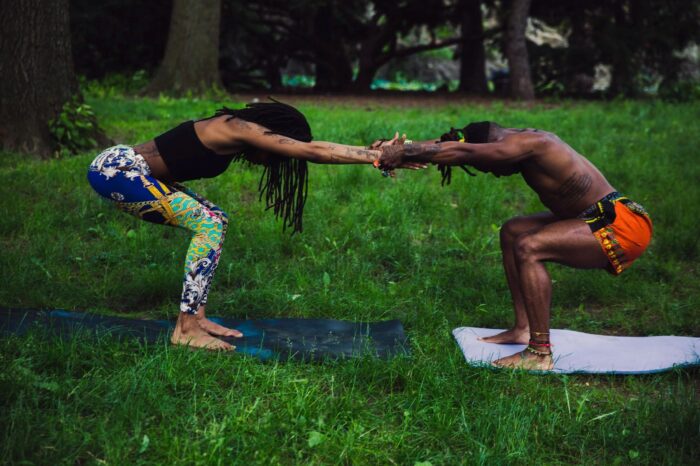written by Jo WeHunt, Certified Fitness Trainer and Mobility Coach
What is Mobility, and Why do you need it?
Mobility refers to moving freely in a joint range and relates to the joint. It is dependent on how much movement there is without restriction by the surrounding tissues (tendons, ligaments, fascia, and muscles) (Hali and Calum, 2020).
In other words, mobility is your move-ability. How freely you can move around in each joint in your body, and flexibility is the ability to do this without pain or strain. We need mobility (flexibility plus mobility), stability, and strength in each joint range to be mobile and injury-free. These elements create effortless flexibility in our bodies and help us move and feel our best.
Tightness is created by our brains and sensed in Golgi tendons in our bodies. (Hali and Calum,2020) After an injury or prolonged physical inactivity, tightness can be felt in many body areas. This can be structural or joint-related. Things like hip dysplasia or hip bursitis are structural. Joint-related restrictions include a lack of flexibility of the muscles surrounding the joint and fascia. In both cases, mobility can help, but it might take longer and require more regressions for structural issues to repair. Not to worry, though; training our joints gives them some much-needed blood flow to help speed up the repair and recovery process that they wouldn’t get otherwise.
I like to think of aches and pains and extreme tightness as a governor of the body. Letting us know that specific movements are too much for the body to handle, and a load of that exercise exceeds the capacity of the human doing the activity. This means that regressions are required so the mover can work up to that movement capacity and stay pain-free. It also means it is time to take a step back and figure out the root cause of the discomfort with mobility training.
For example, most of my clients and class participants have trouble executing a deep and pain-free squat position. This is most likely because this movement was not practiced for most of their lives, and their bodies let us know that with tightness and pains. The body compensates for lack of mobility by putting stress on joints rather than muscles during a movement. For example, the knees hurting when we squat does not mean we have “bad knees”; instead, it probably means we aren’t moving correctly at the hip and the ankle (which causes extreme tightness in the surrounding areas of the body), which puts undue stress on the knees. The location of pain or excessive tightness is rarely the only issue. Instead, it is the weakest link in the chain, and the whole body needs to be considered.
We can fix the squat by getting to know our bodies a little better and getting a functional movement screening done by a professional. Then we can warm up the hip and ankle joints with various techniques (joint rotations and dynamic flexibility movements). After this, we tackle the areas with limited joint function with mobility work (hovers, rotations, and isometrics). Then with the joints nice and warm, we can perform a regressed version of the squat that the client feels safe doing (which is key to progress) and work up to a full deep unassisted squat with time and consistency. Eventually, we will be able to add weight to the squat in this deep position and create lasting flexibility, mobility, and strength.
This works with any area or movement that you are having trouble with.
This is my general mobility plan of action:
- Assess and see which joints are restricted with a Functional Movement Test. Hire a coach that offers this and one who can take you through this process.
- Perform joint rotations and warm-up drills for the whole body.
- Use release work to alleviate pain and chill out the nerves.
- Use strength techniques like hovers, isometrics, and rotations to increase joint range of motion and end range strength.
- Regress strength exercises and perform with good form (maximal range of motion) and slow tempo to create lasting strength in the joint ranges you have worked on.
- Use static stretching and recovery techniques to improve mobility and flexibility further.
Lastly, be consistent. It takes time to see lasting changes in mobility. Most importantly, listen to your body. We want to work in pain-free ranges of motion and stop when the body has had enough before getting fatigued. I am always telling my clients to move in a comfy range for their bodies as this is the best way to see improvement over time.
In addition, we have to consider nutrition and sleep quality as essential factors in recovery from injuries and mobility improvement. Without good rest and quality food intake, the body cannot recover and heal from aches and pains.
This new training can cause soreness and fatigue like traditional strength workouts. You will need rest days and recovery time. I like to think that mobility is synonymous with strength work, but instead of targeting a muscle, we target a joint function and the muscles helping and opposing that joint action.
Why do you need mobility?
There comes the point in everyone’s life and fitness journey: you will feel aches, pains, stiffness, injury, or tightness that stops you from moving how you want to and progressing towards your goals. This is why preventative mobility is so essential. It can prevent these adverse effects and “bulletproof” your body against future injury.
Also, within the sports and fitness activities you currently do, mobility can help you perform better with more ease. A 5–15-minute mobility-focused warm-up can allow you to run faster, lift heavier and feel way more flexible. It enables you to get stronger and finally progress again in the activities you love to do. This means more muscle growth and better performance every time, so you never have to plateau again.
Gone are the days when mobility was just for the injured; every human can benefit from it in every part of their life.
The most rewarding aspect has been the lasting relief of all my body ailments. I wake up feeling flexible and mobile without having to do any stretching after years of being in chronic pain. Also, I can now move in ways that I never thought were possible for me- handstands, backbends, and single-leg squats. It feels so freeing and fun to move in whatever way I like.
It is incredible to take clients on this journey, at first to relieve their aches and pains, then to see them become lifelong movers who love to be active because of how good they feel in their bodies and how good movement makes them feel. This is what I want for you and everyone else who goes on their mobility journey.
Lasting relief from bodily ailments, connecting back to your body and how it feels and using this new awareness to allow you to quickly move around and do the things you love with the people you love for your whole lifetime. I have seen it firsthand with some of my older trainees; they now move better than some of the 20-year-olds I see at the gym, and exercise is no longer a chore they have to do to stay in shape, rather something they get to do that feels empowering and helps their health and bodily ailments.
This is a fantastic way to create a lasting healthy relationship between fitness and our bodies. Movement doesn’t have to be punishment rather the perfect healing modality for bringing you back to your best self.



